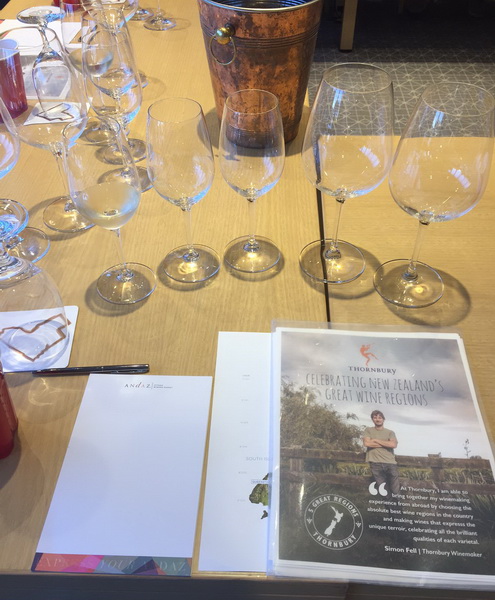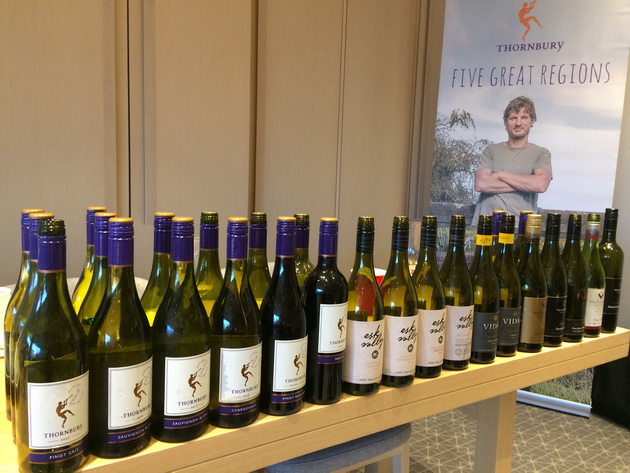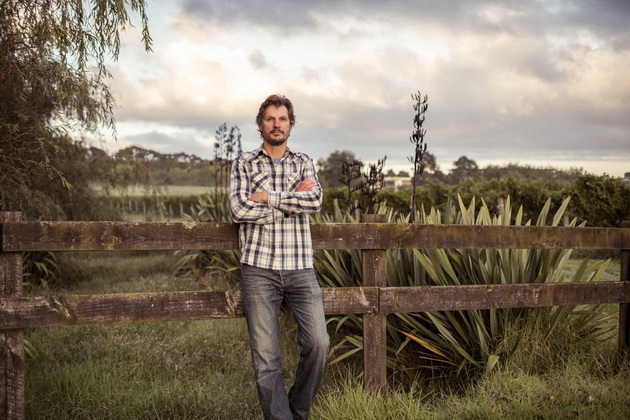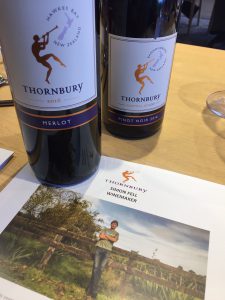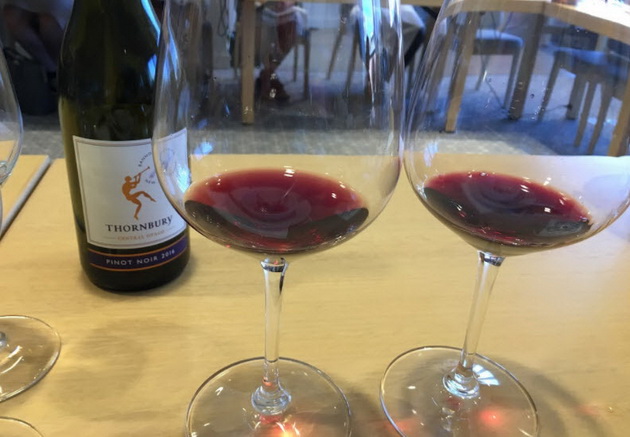Recently, Canada’s top wine writers gathered in the nation’s capital for a comprehensive tasting of Thorbury wines with head winemaker Simon Fell.
You can watch our Live Video Wine Tasting on Facebook right here.
David Skinner
Wine & Travel Columnist, Outdoor Magazine
In New Zealand the wine trail always seems to lead to one of Villa Maria’s cellar doors. The flagship brand is represented by over 60 labels but founder, Sir George Fistonich, has been adding other great regional wineries to the family with quality and diversity driving his search for excellence.
Thornbury, one of the more recent acquisitions (2005), is led by winemaker Simon Fell and his impact on this label was obvious to all at a tasting with some of Ottawa’s top sommeliers.
The Thornbury label, graced by the image of Dionysus, celebrates each of the six distinctive growing regions of the shaky islands (so named for the frequency of earthquakes that keep the native Kiwis on their collective toes). The wines from this lineage do not attempt to be driven by market tastes and preferences, but gain their deserved reputation for quality from a more terroir-driven approach.
Choosing specifically suited varietals from each region promotes the best expression of the land, climate and fruit that nature can provide.
Under the nurturing care of Mr. Fell, the regional varietal focus of Thornbury is rather unique and some may perhaps think is a bit risky. The Greek God of Wine may have also been known as the God of madness, but Simon has a virtuous method to his madness.
Prior to arriving at Thornbury, Simon honed his craft at Esk Valley Estates; another of Villa Maria’s premiere properties. His tenure working the famous soils near Napier was to be a fruitful experience that, when added to his time spent in France and Chile, gave this gifted craftsman a well-rounded skill set to manage the five diverse regional wineries now in his charge.
Thornbury’s most southerly property is found in the austere Central Otago region, where Pinot Noir has gained an international reputation for quality and value. The Pinot vines yield may be low due to the dry silty slopes and hot summers, but cool nights and careful stewardship permits the pinot to express classical dark cherry notes along with spice and herbal accents.
Travelling northward on the South Island, Waipara is located outside Christchurch and near the coast and the western mountains. It is here that Pinot Gris and Riesling have found a home where they can flourish and produce wines of great intensity and crisp acidity. Nothing could express the notion of summer in a glass better than these two offerings.
Of course, no portfolio of New Zealand wines would be complete without a Sauvignon Blanc from Marlborough.
Thornbury is no exception and they have chosen to make use of the diverse microclimates in this dense wine region to make a distinctive style. Along the path of the Wairau River, the soils range from shallow, stony and well-drained, to clay and silt, both of which makes for Sauvignon Blanc with classic gooseberry, passionfruit and herbal characteristics.
When blended with grapes from the Awatere Valley where vines struggle along rugged hillsides to produce a more herbaceous and grassy style with citrus notes, the Thornbury expression of Marlborough Sauvignon Blanc brings the best of both into a single bottle.
Hawkes Bay on the eastern coast of the North Island is famous for its stony soils and sun-drenched conditions. The extended growing season permits classic red varietals to prosper.
Meanwhile, the thriving viticultural neighborhood of Gisborne has similar conditions, where chardonnay and other classic grapes can express their best features. Simon’s innovative approach to terroir selection has focused his attention upon Merlot from Hawkes Bay and Chardonnay from Gisborne.
Through this judicious selection of plantings, the Thornbury label fulfills its strategic intention to select only grapes that do well in specific regions and then allow the wines to carry the weight of quality nurtured by loving expertise of a skilled winemaker.
While Simon Fell is primarily responsible for one of the Villa Maria’s labels, he was kind enough to take the Ottawa sommeliers on an organoleptic tour of wines from other brands, such as Anthony Joseph Vidal, Esk Valley of Hawkes Bay and, of course, the flagship Villa Maria offerings. Each of these properties have been awarded numerous accolades and won prestigious medals.
I will have a lot more to say about these wines soon.
Thornbury Sauvignon Blanc 2016
Marlborough, South Island, New Zealand
Kristin Perrin
Accredited Sommelier & Competition Judge
Winemaker Simon Fell, of Thornbury Winery and Villa Maria (to name a few) lit up an entire room for just over 2 and a half hours in the Andas Hotel, downtown Ottawa on Monday afternoon with his enthusiasm and passion for winemaking in some of New Zealand’s top wineries throughout its diverse wine regions.
The country, split into two post-card landscape picturesque islands, holds a multitude of terroirs from top to bottom. Each region has it’s own microclimate within. Although I may have guessed this prior to attending the highly informative tasting, I had no idea of the substantial differences (or the versatility) of the numerous sub-regions.
What surprised, and rather impressed me the most, was its ability to make such refined and beautiful Syrahs! Fell’s modest grin expressed his excitement when he rightfully claimed that these were very reminiscent of Northern Rhône styles of red.
The black current and peppery nose, the finesse of its lengthy finish – the only thing missing from the moment was some fresh New Zealand lamb!
While Sauvignon Blancs and Pinot Noirs continue to dominate the region as a whole (and the exportation of its liquid labourous efforts), Fell admitted that other international grapes, suited to their proper climate and soils of New Zealand, are equally possible.
For example, Spain’s noble white grape, Albariño is currently being experimented with – and according to Fell, is absolutely delicious. He boasts that they are showing loads of peach, apricot and minerality, with a hint of salty sea water, just like in its native region of Rías Baxas, Spain.
Simon educated us on the long-standing history of New Zealand’s oldest wineries, such as Vidal, founded by Anthony Joseph Vidal in 1905 in Hawkes Bay. Vidal’s Hawkes Bay “Gimlet Gravel” 2015 Syrah just happened to be one of my favorites in his 17 wine lineup.
It may have been a tie between the Villa Maria 2010 “Library Reserve” (also from the Gimlet Gravels sub region) made up of 60% Merlot blended with Cabernet Sauvignon. The demonstration of both quality and ageing potential made me think twice about only sticking to Bordeaux in future for options.
What I enjoyed most about Fell’s seminar – was his dedication to the true character of each grape. He didn’t overcomplicate his work. He has an immense respect for the grapes and soils of his native wine making region.
Although he spent much time internationally abroad, learning all his winemaking techniques that assist him today, it is clear that he truly appreciates and respects his homeland; something many of us should be inspired by.
Thornbury Pinot Gris 2017
Auckland, Waipara, New Zealand
Thornbury Sauvignon Blanc 2017
Marlborough, South Island, New Zealand
Thornbury Gisborne Chardonnay 2016
Auckland, Marlborough, New Zealand
Jane Staples
Wine Columnist, Ottawa Wedding Magazine
I fell in love with NZ wines the first time I tried their Pinot Noir. So fruit-driven, but with all those delicious undertones of forest floor, spice and dark chocolate.
Then I went through a Sauvignon Blanc phase and there’s lots of scope there, too. Mouth-watering acidity and an array of herbal-tropical-citrus flavours dancing on the tongue. In a nutshell, I love NZ wines because they are terrifically food-friendly and also because their flavours explode in your mouth.
Recently, I had the opportunity to taste several NZ wines produced by Thornbury, Vidal Wines, Esk Valley and Villa Maria, while Thornbury’s winemaker, Simon Fells, gave a very informative talk about the wines he makes.
There’s nothing like tasting a wine product, together with the winemaker, for learning about the nuances in style that result from different soil types, vineyard exposure, and weather variations in combination with the vinification skills used for each product.
We were very fortunate to have Simon with us. His background includes a Bachelor of Science and a Diploma in Wine Science, along with international experience working with wineries in North and South America, France and Western Australia. He’s a great educator and a very engaging speaker.
He thinks blending is the most exciting part of his job and he clearly excels at his craft.
Our tasting had a definite regional theme, with a focus on five winemaking regions in New Zealand and the award-winning wines that express each unique terroir and the qualities of each varietal. Happily, we learned that New Zealand excels at crafting several other varietals besides their well-known Sauv Blanc and Pinot Noir.
We also sampled Pinot Gris, then a mouth-watering Chardonnay that was quickly dubbed ”crème brûlée in a glass”; next a Merlot and a Syrah. As a special treat, Simon shared an excellent Merlot/Cab Sauv blend from his own collection, which was highly aromatic and velvety smooth, a great testament to New Zealand Cab Sauv.
My favourite wine was the Vidal Reserve Pinot Noir 2015; aromatic, flavourful and silky. I gave that one 93 points and will be looking for it in the February 3, 2018 release at the LCBO.
Thornbury makes expressive wines that celebrate life. Let’s lift our glasses to them! Cheers!
Thornbury Vista
Thornbury Pinot Noir 2016
Central Otago, South Island, New Zealand
Jennifer MacDonald Havers
Wine Columnist, Ottawa Citizen
Speaking with Simon Fell, the winemaker for Thornbury wines out of New Zealand, was a wonderful and informative treat. If you’re not familiar with New Zealand wine, taking a tour around the Thornbury portfolio is a fascinating introduction as their wines span several regions across this tiny but very diverse country.
Our group was lucky enough to be some of the first Canadians to taste the entire portfolio during a lovely lunch event at the Andaz hotel. With the labels of the bottles adorned with Dionysus, the Greek god of wine, we knew we were in for a great experience.
The winemaker strives to make wine that is truly reflective of the varietal style in that particular region. As a result, we were able to taste some textbook examples of New Zealand wines, which showcase these respective regions beautifully.
Truly, many wine varietals can be made in many of these regions, however, the goal of the Thornbury line is to reflect the ideal character of a particular varietal.
The Thornbury line is also somewhat unique in that they do not produce different tiers of wine, such as a reserve line. This is a great benefit to the consumer, as the winemaker is motivated to produce one wine of each varietal that demonstrates the best possible quality at a reasonable price point.
These wines are certainly ones to try when you see them.
 Photo: Jennifer MacDonald Havers
Photo: Jennifer MacDonald Havers
Take the quintessential region of Marlborough. I am sure many wine lovers have tasted a classic Sauvignon Blanc from this region. What always amazes me is the variety that can be found in Sauvignon Blanc from across this relatively small country, from citrus to tropical, as well as the varying herbaceous or “green” notes.
The classic, and most well known examples are from this region, showing beautiful balance, and the typical notes of citrus, bright acidity, and flinty, mineral notes. This Thornbury example was textbook, made your mouth water, and would be a great summer wine for a range of seafood or vegetable dishes, or just a refreshing sipper.
And as though this journey through the Thornbury portfolio of wines was not satisfying enough, we were also treated to a few special selections from Esk Valley wines, and some reserve Villa Maria wines. We have seen and tasted much of the Villa Maria range before, but these wines showcased specific winery sites, in particular for the Pinot Noir, and were a great testament to the quality and prestige of the label.
The diversity of wine from New Zealand is really quite impressive – there is more to love than just Sauvignon Blanc!
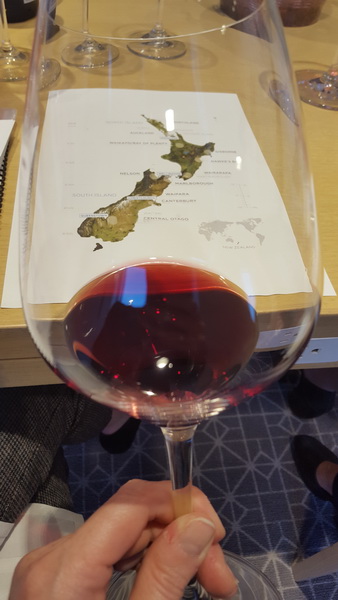 Photo: Jennifer MacDonald Havers
Photo: Jennifer MacDonald Havers
Thornbury Merlot 2016
Auckland, Hawkes Bay, New Zealand
Dr. Simon Chen
Accredited Sommelier
We had the honor today to meet with the winemaker, Simon Fell, of Thornbury Winery from New Zealand, and sampled all their wines and also many other wines from their sister wineries (Villa Maria, Esk Valley, and Vidal). Thornbury winery does not own any vineyards.
It is because Simon’s winemaking philosophy is to showcase the grape varietal with different iconic wine regions in New Zealand. All the wines are 100% single grape varietal and single vineyard, and the wines are minimally treated so they can reveal the true characteristics of terroir.
Indeed, I certainly experienced the terroir in their Sauvignon Blanc and Pinot noir today.
Thornbury winery’s Sauvignon Blanc is sourced from the Wairau Valley in Marlborough. Wairau Valley is in the northern part of Marlborough and Sauv. Blanc in this region, tends to be more ripe, full bodied, and has tropical fruit (passion fruit)-like tasting profiles. The 2016 vintage truly delivers all these characteristics, and it is one of my favorite Sauv. Blanc of the day.
We also had the opportunity to do a mini vertical and tried their 2017 Sauv. Blanc future release, side by side. Interestingly, the 2017 Sauvignon Blanc has less body, acid, and structure, due to the cooler vintage, but it still consistently delivers the beautiful tropical fruit (in this case-guava) aromas, showcasing the terroir of Wairau Valley.
We also tried a Sauvignon Blanc made by Villa Maria, which the grape is sourced from the Awatere Valley, Marlborough. Awatere Valley is in the southern region Valley of Marlborough and Sauv. Blanc in this region is more grassy, citrus, and stone fruits.
It displayed a completely different flavor profile than Wairu valley, which is only a 2-hour drive apart.
Thornbury winery’s Pinot Noir is sourced from the Bannockburn Valley near Central Otago, which is 884km south from Marlborough. Simon pointed out that due to the position of Central Otago, it is probably the only wine region in New Zealand that is not affected by maritime weather.
Thornbury winery’s Pinot Noir is perfumy and has fresh and rich red fruits notes (very new world style). In contrast, we tasted the Pinot Noir from Esk Valley Winery, which is sourced from Marlborough.
In this wine, I can clearly taste the earthiness, dark cherry, and more stringent acid, which gives more Burgundy-type style to the wine.
Lastly, we tried several Merlot, Syrah, and Bordeaux blends, which I don’t usually associate with New Zealand wine. I learned that most of these grape varietals are grown in Hawkes Bay.
Hawkes Bay is in the northern part of New Zealand, and it is 600 km north from Marlborough. The warm climate and lengthy growing season are suitable for Cabernet, Merlot, and Syrah.
The 2010 Merlot/Cab Sauv Blend from Villa Maria is amazing. The wine is savory, black fruits, plum, and full body. Overall, the style of these grape varietals actually reminds me a lot of the wines from Okanagon, BC =D
Esk Valley Pinot Gris 2016
Hawkes Bay, New Zealand
Sylvain Segard
Accredited Sommelier
If you’ve ever tasted wines from New Zealand in the past, you likely came across the Thornbury Wines label, with its picture of a golden pipe piping Dionysus on the front. And, you have probably grown accustomed to getting strong value for these pleasant, fruit-forward wines.
It is again the case this year with the 2017 release of the Thornbury’s Wines’ line up, which brings vibrant and refreshing whites and elegant reds to a LCBO near you this Fall.
Simon Fell, Thornbury’s winemaker, was touring Canada at the end of September, to introduce his wines, to wine writers and sommeliers, as well as a selection of wines from the Villa Maria family of New Zealand wineries. In Ottawa, he stopped at the Andaz Hotel on Monday September 25, 2017 to host a workshop with the wine review team from NatalieMacLean.com
We reviewed 18 wines grown across five different regions of New Zealand and produced by four of the Villa Maria family’s wineries: Thornbury, Esk Valley, Vidal, and Villa Maria.
New Zealand is blessed with several mountain ranges, beautiful geography, a mixture of coastal and interior climates, and diverse soil geology which make it a winemaker’s dream. This diversity and richness of terroir is reflected in the range of wines we tasted.
The grape varieties vinified by Thornbury and its sister wineries are those you would expect from the well-known vineyard regions of New Zealand — e.g. Sauvignon Blanc in Marlborough, or Merlot in Hawkes Bay.
However, as the vinegrowers and winemakers of the Villa Maria family continue to focus on increasing quality, they are also exploring different grape varietals, such as Albariño — a crisp citrusy white, and are encouraged by the owners to pursue different approaches to wine making.
For example, the Vidal Estate winery espouses artisanal methods in crafting classic low run fine wines.
As a young winery in a young wine country, we are likely to see more interesting things emerge from Thornbury in the future.
Esk Valley Sauvignon Blanc 2016
Hawkes Bay, New Zealand
Esk Valley Pinot Noir 2016
Hawkes Bay, New Zealand
Esk Valley Winemakers Reserve Syrah 2013
Hawkes Bay, New Zealand
Vidal Pinot Noir 2015
Hawkes Bay, New Zealand
 McDiarmid Hill Vineyard Gisborne
McDiarmid Hill Vineyard Gisborne
Vidal Reserve Syrah 2015
Hawkes Bay, New Zealand
Rachelle O’Connor
Wine Writer & Competition Judge
As Simon Fell, the winemaker from Thornbury wines, took us on a journey through their portfolio, it truly feels like you are standing in the vineyard as he speaks of the challenges and success they faced while focusing on reaching their end result….”creating wine that are first and foremost enjoyable to drink; wines that go well with food; and wines that simply celebrate life”.
As the logo on the bottle depicts – “Dionysis the Greek God of Wine; representing the fun and expressive character that “epitomises our wine”.
For over a decade, Simon Fell has been creating the beautiful expressions in these wines across various key winemaking regions in New Zealand.
Firstly, Gisborne – located North of Hawke’s Bay on the east coast of the North Island and most notably its claim to produce the best Chardonnay in New Zealand with its sunny climate. The 2016 Chardonnay that we sampled was so rich in flavor – juicy pineapple, ripe melon, fig and harmonious layers with a refined elegance.
The second region, Hawke’s Bay, also known as “Wine Country”– with a more moderate climate, make it ideal for red grape varieties and home to many of the most highly regarded wineries in the country. The Hawke’s Bay wine trail is on my bucket list for sure.
A lovely Merlot from the Gimblett Gravels wine district, within the Hawke’s Bay region of New Zealand – although it is a small area, has made a big impact on the New Zealand wine market in a short span of time. The first grapes were planted in 1981 – and by 1991 only 50 acres were planted. Today there is over 1500 acres planted.
The climate and soil makes it a perfect place to grow Merlot. Also, heavily planted are Cabernet Sauvignon, Chardonnay and Gimblett Gravels Syrah. The soil and climate of the area are directly correlated to the quality of grapes grown in that area.
The gravels we speak of are alluvial (a fertile soil type composed of fine grained elements such as clay, silt, sand, and gravel/stones – occurring when these sediments are deposited by flowing water). In this case “greywake” washed down from the Ngaruro River.
The soil drains freely, preventing the vines from becoming water logged pushing them to grow longer, stronger root systems. The heat retention of the clays and reflection from the pebbles, allows the grapes to truly reach their full potential ripeness.
Gimblett Gravels is sheltered from the immediate coastal breezes but benefits from a moderated Maritime climate.
Thirdly, Marlborough – the pillar of New Zealand wine-making – and internationally acclaimed status for award winning Sauvignon Blanc – the region boasts a cool climate as well as long, hot Summer days. The Thornbury Sauvignon Blanc is sourced from two well-known areas: the Wairau and Awatere Valleys.
The fourth region, Waipara – not from the sea and sheltered by Mountains in North Canterbury. Thornbury vineyards here are North facing on moderate slopes – home to the Thornbury Pinot Gris.
The vintage we tried – 2017 – is a little different in style. Simon usually makes it off-dry, but not this year, there is a simple purity of fruit, a crispy brightness, medium sweet and very versatile with many foods.
Lastly, Otago – with the most Continental climate of all the New Zealand wine regions. Well known for Pinot Noir here – the growing season is shorter – hot Summer and low rainfall, resulting in rich, complex wines.
The 2016 vintage is beautifully presented with a nose and supple flavors of dark cherry, plum, spice, herbs and silky perfumed undertones. In his words, “the 2016 vintage was excellent” – a great representation of the soil and climate coming together to magically create some outstanding wines.
Truly a delight from start to finish. I look forward to one day visiting these vineyards in person, to truly appreciate all the efforts that go into the production of these wines – but having Simon share his passion and knowledge was the next best thing to standing in the vineyard!
Villa Maria Estate Cellar Selection Organic Sauvignon Blanc 2016
Marlborough, South Island, New Zealand
Melanie Lloyd
Accredited Sommelier
I had the pleasure of attending the wine tasting with New Zealand’s Thornbury Wines and their head winemaker Simon Fell. Thornbury Wines is part of the Villa Maria Estate family.
This presentation featured Thornbury wines as well the following New Zealand brands under the Villa Maria Estate: Esk Valley, Vidal, and Villa Maria.
Simon Fell is a friendly and charismatic fellow who seems pretty laid back and who is very passionate about making wine. His first priority as a winemaker is to make a consumer-friendly wine. The second priority is to make wine that respects the region where it is produced. To this effect, Thornbury wines have grapes growing in five different regions.
Here’s what I learned about Thornbury wines:
The fruit and the terroir are the expression of the wine. Simon mentioned that in the early days they planted everywhere. Now there is more age on the vines and they have figured out what works well.
The use of oak has been fine-tuned because of a better understanding of the fruit. They are no longer trying to make something that mimics French wines as they found their own identity. In the wines, you taste purity of the fruit as well as qualities of the region.
Regarding the terroir, there are lots of micro-climates in New Zealand. You find lots of diversity.
Simon explained that you only need to travel one hour and you get a completely different micro-climate. It is important that the wines stay true to the region or sub-region.
One of the interesting facts I learned was concerning the region of Central Otago, famous for its Pinot Noir. Simon mentioned that around the world, the growth cycle of grapes typically takes 100 days, from flowering to harvest.
In Central Otago, this period is extended to 120 days. Also, Central Otago is probably one of the most continental grape growing areas of New Zealand as there’s not a huge maritime influence.
So what’s the next big wine to come out of New Zealand according to Simon Fell? Pinot Noir, as we are already witnessing.
I found out that currently, outside of New Zealand, the number one international buyer of New Zealand pinot noir is the UK, followed by Australia.
Syrah is also showing great potential. The quality of the Syrah is starting to gain recognition.
Another wine variety that is promising is Albariño, to my surprise, which is currently being produced in small quantities.
Overall, I enjoyed the wines we sampled. I found that the white wines tended to have mineral aromas while the red wines tended to be earthy.
Here are a few notes on some of the sampled wines:
The Thornbury Marlborough Sauvignon Blanc 2016 is a crisp wine with passion fruit, lychee, citrus, and mineral aromas. Sauvignon Blanc is what Thornbury produces the most. Simon explained that Sauvignon Blanc is not all about grapefruit and high acidity. In warmer climates, you get more tropical fruit such as with this wine, which is made from a combination of grapes from the Wairau and Awatere area.
The Thornbury Central Otago Pinot Noir 2016 has black cherry, blueberries, and floral aromas. Thyme is also present. Simon mentioned that there is thyme growing all over Bannockburn where the vineyard is located which is why you can detect this aroma. On the palate, it has silky tannins, berry flavours and a touch of spice.
The Esk Valley Hawkes Bay Pinot Gris 2016 has pear, bruised apple, caramel, and mineral aromas. It is off-dry with a slight bitter finish. Simon explained that the wine at Esk Valley is more artisan style. It has more texture and is more food friendly. The wine has more contact with grape skin than the Thornbury Pinot Gris which helps with this texture.
The Villa Maria Cellar Selection Organic Sauvignon Blanc Marlborough 2016 is an organic wine that meets our strict Canadian standards. I learned that only two organic yeasts can be used to be certified organic in Canada. Also, the levels of sulfites need to be very low. This is a nice light and crisp wine with aromas of passion fruit, lychee, citrus, and a touch of petrol.
I was also very fortunate to taste the Villa Maria Library Release Merlot Cabernet Sauvignon Gimblett Gravels 2010 which has aromas of raspberry jam, autumn leaves, potpourri and a touch of menthol. It is full bodied, complex, and the tannins are well incorporated. Overall, it is a very lovely wine, what a treat! It contains 62% Merlot and 38% Cabernet Sauvignon.
As a final note, this was a good event and I had fun! Simon Fell was a great presenter and it was nice to try these wonderful New Zealand wines.
Villa Maria Estate Reserve Sauvignon Blanc 2016
Clifford Bay, Marlborough, New Zealand
Pam Chiles
Wine & Food Writer
Interesting, informative and engaging, Thornbury winemaker Simon Fell led a group of Ottawa wine writers and sommeliers through a tasting of a collection of New Zealand wines. Thornbury is part of the Villa Maria fold, a vast winemaking enterprise with history going back decades.
Thornbury produces easy-drinking, “crowd-pleasing” wines, as described by Simon – so true! The attention to quality is very high and the wines on the whole reflect this. All were thoroughly enjoyable – these are the kind of wines to have on hand for any occasion.
Photo: Pam Chiles
Although the tasting and presentation focused on the Thornbury range of wines, our group was also treated to a sampling of other wines in Villa Maria’s portfolio: Esk Valley, Vidal, and a few of the namesake Villa Maria line. They express great varietal character, showing regional and local variation as well.
Sauvignon Blanc seems to be the bread-and-butter of New Zealand winemaking, but other varietals are produced in significant quantities throughout the country: Pinot Noir, Pinot Gris, Syrah, Chardonnay and Cabernet Sauvignon, to name a few.
Photo: Pam Chiles
I am intrigued by New Zealand Pinot Noir, and find I am drinking more of it of late, so it was a treat to try several on this day, three from Marlborough, one from Central Otago, each from the different Villa Maria portfolios: Thornbury Central Otago 2016, Vidal Marlborough Reserve 2015, Esk Valley Marlborough 2015, Villa Maria Private Bin 2016.
Different vintages, but fascinating to see the range of expression Pinot can take on – fruity, fresh, earthy, simple, complex, etc. Interesting to learn that Central Otago Pinots take about 20 days longer than other NZ Pinots to ripen, the region being the southernmost in the country.
All the Pinots tasted have an elegance and finesse and range of complexity. I quite enjoyed all four and would happily sip any, at anytime!
When it comes to Pinot Noir, Simon remarked that New Zealand is “not looking to emulate Burgundy anymore.” The Kiwis are secure and happy enough in their own successes to express their own particular version of the heartbreak grape.
Photo: Pam Chiles
One grape coming out of New Zealand to watch for, according to Simon, is Syrah. He notes Hawkes Bay is producing some serious Syrah and we were delighted to try the Esk Valley Winemakers Reserve Gimblett Gravels Syrah 2013.
This small production wine comes from a single vineyard where yields are kept low and grapes are hand-harvested. Be on the lookout for more New Zealand Syrah in the future!
Photo: Pam Chiles
Simon says Pinot Gris will very soon take over Chardonnay in amount/acreage of plantings in New Zealand. It makes a marvellously expressive wine and we were able to taste two versions: Thornbury’s Waipara (Marlborough) and Esk Valley’s Hawkes Bay.
The wines were paired with delicious food from Andaz’s kitchen. Many thanks to Andaz and of course to Simon Fell for sharing his knowledge and stories with us!
Villa Maria Estate Southern Clays Sauvignon Blanc 2016
Marlborough, South Island, New Zealand
Andrea Shapiro
Accredited Sommelier
I was invited to a taste and greet with Simon Fell, winemaker of New Zealand’s Thornbury wines, at the Andaz hotel in Ottawa’s historic Market region, along with a few other select sommeliers and wine writers with Natalie MacLean. I had the pleasure of sampling some of what was offered.
Many of the wines are made using grapes that grow in five different regions of the country, and with the many challenges and aspects of growing, harvesting and using different winemaking styles. We tried six different wines from each of those regions and they fully express the unique terroir and circumstances under the skilled hands and guidance of Simon.
Thornbury operates under Villa Maria’s umbrella of wine family which also include, Esk Valley, Vidal and Villa Maria. We were also fortunate enough to try a few selections of wines from these too.
From the Waipara region of New Zealand, we tasted the Thornbury Pinot Gris 2017. It is known for it’s warm days and cool evenings with north facing vines which allow vibrant sun exposure to bring flavour to the fruit. Delicate and off-dry with peach, apricot and pear, accompanying some delicate butterscotch notes, creamed caramel and hints of butter creaminess.
It has a lively oily texture and mouth-feel which was an aspect of it being left on yeast lees post fermentation, contributing to this lovely and decadent white wine with a hint of sweetness at the end.
The 2016 Thornbury Chardonnay is a blend of grapes from Gisborne’s Patutahi and Manutuke regions located on the North Island. It displays notes of grilled pineapples, vanilla wafer cookies and smoke. It was reminiscent of sitting next to a campfire and toasting marshmallows.
This is an element of being aged for almost a year in barrel before blending, giving it it’s oaky chard characteristic, like a Californian chardonnay in style. It offered a rich creamy texture balanced with bright medium acidity.
Photo: Andrea Shapiro
We were then given the opportunity to taste two select side by side vintages for a horizontal tasting between Thornbury Sauvignon Blanc 2016 and 2017.
Grapes were harvested and selected from the Awatere and Wairu valley regions. The blend of the two helps to bring some of the distinct “Sauvie” characters to the wines offering mineral and steely elements from the Awatere and fresh fruit driven aspects reflected in the Wairu terroir.
The growing season was cooler in 2017 than 2016. The main difference between the two was the earlier vintage had elements for bright crispness, some gooseberry and grass notes while the latter was also crisp, with green bean but fruitier with tropical fruit and zippy pineapple which brought the acidity and softness into play.
Overall both were lovely, yet unique. Much like the earth and land in which they hail from and were born to express.
Thornbury Vintages and Varietal Contrast and Compare: Pinot Noir and Merlot
Here, there are two side by side examples of very fine wine. To the left, the Pinot Noir 2016. Vines are grown in the Cromwell region of Central Otago.
Grapes were hand harvested and underwent a 5 day cold soak. A gorgeous pale ruby colour with red fruit, cherry, plum and some delightful earthy and leafy notes with a clean light finish. This was an outstanding pairing for the borscht.
The sweet notes found in the earthy beets complemented the same aspects revealed in the wine. Intrinsically intertwined. In contrast to the Merlot, this fuller bodied ruby red wine hails from the Gimblett road region grown on Omahu Gravels in Ngakirikiri Vineyard of Hawke’s Bay.
Flavours of the Hungarian and French oak staves were used here and the flavours imparted were outstanding. Chocolate and herbs with a robust body and delightful richness. Two red wines with two different sets of characteristics.
Both were excellent examples of red wines from each region. The Pinot Noir, light bodied and earthy, balanced against the Merlot’s plummy larger bodied elements.
A unique varietal for this area that is not often considered, was The Vidal Reserve Syrah 2015. This was also grown on Gimblett Gravels, specifically Omahu and Twyford vineyards in the Hawke’s Bay region.
Syrah grows well here and shines with elements of dark plum, ripe cherry and a peppery finish. During the open ferment process in small batches, it was hand plunged and then pressed off into French oak barrels and aged for 17 months.
It made for a savoury, and succulent surprise. This wine would pair well with a nice pepper steak and good company to be enjoyed.
It was enlightening to learn of some of the finer nuances of New Zealand winemaking. Simon was charismatic, engaging, and inspiring which was also reflected in his wines.
Through his stories, and education it allowed me to appreciate New Zealand in ways I had not experienced before, through the eyes of this passionate and skilled winemaker. Thank you for sharing your contagious inspiration. Look forward to what the next vintages will bring!
Villa Maria Estate Private Bin Pinot Noir 2016
Marlborough, New Zealand
Greg Hughes
Wine Writer & Sommelier
This was the first full tasting that Thornbury / Villa Maria had been able to organize in Canada.
Our guide for the evening was Simon Fell, who has been with Thornbury for 15 years. Part of his job was the centralization of the winemaking for Thornbury.
The office in Auckland is his lab. It is a multi-regional wine company. Their brands focus on six wines from five different regions: Otago Pinot Noir, Marlborough Sauvignon Blanc and Pinot Noir, Cantebury Pinot Gris, Hawkes Bay Merlot, Gisborne Chardonnay.
As someone intimately familiar with Niagara and their continental climate, sometimes you envy New Zealand and their climate. There is vintage variation, though the climate is balmy and cool-climate mediterranean. It is actually the most southerly region on the planet.
2013 and 2014 were apparently vintages of note. 2015 was average and typical. 2016 turned out better than expected.
2017 was a difficult year. New Zealand had three giant cyclones roll through on a season with late fruit set. It affected yields and ripening.
2016 had a cool start, but also it was hot, so they managed the physiological ripeness necessary.
It was fantastic to see the differences in the regions set out before us. Pinot Noir in the south, in Otago, gets five extra weeks of ripening over Marlborough to the north. It is grown on fine loess and gains a silky texture, but also has much more in the darker fruit end of the fermentation.
To coax out the flavour, there is a lot of mixing styles. Used oak for a year, maybe, with 20-25% new oak. Wild fermentations, extended macerations.
They definitely seems to have nailed their cooperage too. Paying attention to how the barrels are made, either through water immersion or the toast.
Working in a young region, they employ a lot of sophisticated technology, but they use traditional tech as well. They use a lot of concrete tanks in fermentation. Big open top tanks made of concrete and sometimes oak really work out a nice texture in their Pinot Noir, especially their Vidal series, named for their founder.
Vidal’s vineyards are actually some of the oldest operating vineyards in New Zealand. It was founded in 1905. This wine has some soft red fruit on the palate. Its extraordinary freshness comes from a unique practice that demonstrates their guarantee to quality.
They delay the malolactic fermentation on the pinot. It goes into tank until the spring and then it finishes the process. It gives it more richness and generosity, but it preserves the primary fruit wonderfully.
We were able to taste two wines from Villa Maria’s lineup that demonstrated the stringency of Canada’s ‘organic’ laws. Villa Maria now produces an organic Sauvignon Blanc and we were able to compare it alongside the non-organic example.
Organic is actually quite restrictive in what it permits winemakers to do to their wines. It disallows certain additives to wines, but there is also a list of permissable yeasts.
New Zealand Sauvignon Blanc gets much of its tropicality through yeast choices that emphasize tropicality. A type chemical called a thiol is excreted by non-organic yeast. This tastes like passion fruit, giava, and other fruit.
Tasting the typical Sauvignon that displayed this characteristic, it was interesting to see how this changed with the organic example. It exuded vegetal flavours of fern and snap-peas. It was still crunchy and green, but less ripely fruited.
Both wines had merit, but if these regulations affect the quality negatively or restrict the creativity of the winemakers, maybe they need to be reevaluated or approached with more prudence.
Greg is a wine raconteur interested in the education and appreciation of wine and other consumer luxuries. He has studied with the Wine Council of Ontario, the Wine and Spirit Education Trust (WSET), and The Wine Scholar Guild. He is currently engaged in a graduate degree in legal studies focusing on the risk and regulation of controlled substances.
Villa Maria Estate Library Release Merlot Cabernet Sauvignon 2010
Hawkes Bay, New Zealand
Cherie Cole
Restaurant Wine Consultant
Thornbury – A Taste of New Zealand
Tutored Tasting with Winemaker Simon Fell
On September 25th, 2017, a small group of us gathered at the Andaz hotel to meet Simon Fell, the winemaker from New Zealand’s Thornbury Wines.
Having just arrived from a long journey that took him halfway around the world did not interfere with Simon’s energy and passion he has for wine and specifically, the fabulous wines of New Zealand.
This was Thornbury’s first, full tasting in Canada, hence a very special privilege for those of us who attended.
The tasting commenced with six wines from the Thornbury collection, including the fragrant 2017 Pinot Gris, the incredible 2016 and 2017 Sauvignon Blanc, the fruity and smokey 2016 Gisborne Chardonnay, the elegant 2016 Central Otago Pinot Noir and ending with the delicious 2016 Hawkes Bay Merlot.
One-hundred percent of New Zealand wines are screw cap. Why you ask? Corks are expensive and anywhere between 5-8% of the wines end up with cork taint.
We tasted a 2010 Villa Maria Merlot/Cabernet Sauvignon blend with Simon and it was superb! Hence, wines with age potential can still taste amazing from “corkless”, screw cap bottles.
New Zealand, as we learned from Simon, is very unique in many ways from geography, soil, climate and culture, creating wines that reflect the best attributes of the various regions within the two islands that make up this beautiful country.
After his extensive winemaking experiences in Bordeaux, California, Chile and Australia, Simon came back to New Zealand and consolidated all the winemaking for Thornbury into the Aukland location.
Thornbury’s focus is to create a fruit-driven, consumer-friendly wine that showcases elegance and consistency from the regions that present the best expression of each varietal.
The five main regions of Thornbury’s wines are:
Gisborne
Known as the Chardonnay capital of New Zealand, Gisborne has eight different sub-regions. The Chardonnay from this region presents a full body with notes of melon, caramel and a hint of smoke.
If you happen to be in the Gisborne area during December, you can attend the Rhythm and Vines festival which is held annually from the 29th to the 31st. This three-day festival is a compilation of music and wine to celebrate the first sunrise of the year. Founded in 2003, the festival hosted 1,800 attendees and has since grown into a multi-day event with over 25,000 people in attendance.
Hawkes Bay
The 4500 to 5000 hectares of wine-growing area in Hawkes Bay is set-aside for vines containing Merlot, Cabernet Sauvignon, Chardonnay and Syrah.
The abundance of river deposits in this area give rise to wines with pretty fragrance and elegant structure. For Merlot lovers, Hawkes Bay and Aukland are the only two areas of New Zealand to grow this varietal.
Marlborough
Home of some of the world’s best Sauvignon Blanc wines, Marlborough’s valleys provide the perfect climate to create the tropical fruit and herbaceous flavours with crisp acidity consistently found in the wines from this area.
Waipara
Situated on the East Coast of the Southern Island, Waipara sits between the ocean on the east and the mountains on the west. This location creates the perfect climate for grape growing with warmer days and cooler nights. The Pinot Gris we tasted with Simon hails from this region with just 27 hectares allocated to this fragrant varietal.
Central Otago
This is the most southern and continental grape growing region of New Zealand. With its diverse sub-regions, Central Otago is the mecca for Pinot Noir.
It’s growing season is longer than other Pinot Noir regions in the world totalling 120 days. This extra hang time allows the grape to develop complex and fragrant aromas and flavours.
What I really love about these tutored tastings, is the opportunity they offer, to learn about the evolution and creation of wine from various regions of the world. The most satisfying part is experiencing first-hand, the passion and love the winemakers have for their craft and their country.






